Ghosts in the ROM
While digging through dumps generated from the Apple Mac SE ROM images we noticed that there was a large amount of non-code, non-audio data. Adam Mayer tested different stride widths and found that at 67 bytes (536 pixels across) there appeared to be some sort of image data that clearly was a picture of people. The rest of the image was skewed and distorted, so we knew that it wasn’t stored as an uncompressed bitmap.
After some investigation, we were able to decode the scrambled mess above and turn it into the full image with a hidden message from “Thu, Nov 20, 1986“:
Read on for the reverse engineering details of how we recovered this and the other three photographs stored in the ROM, and some information about the Motorola 68000 era Macintosh.
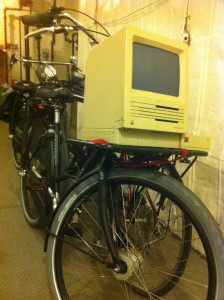
We found this Macintosh SE on the side of the road in Brooklyn and carried it to NYC Resistor. It boots, but lacks any media, so we decided to do some further digital archeology.
We removed the two ROM chips (the ones in the middle of the board, above the VLSI ASIC that is the Integrated Woz Machine) and dumped them with my PROMdate device. The pinout for the chips is the same as the M27C512 PROM, but with the Vpp pin reused for A17. Since it is a mask ROM that can’t be reprogrammed there is no need for the programming pin (Thanks, Nick!). This exapnds the address space to 128 KB (1024 kilobits) compared to the 64 KB of the M27C512 programmable ROM.
The m68k has a 16-bit wide bus, so each 128 KB 8-bit ROM has half a word and they need to be merged into a single 256 KB binary file. We knew we had a good dump and merge when strings on the file contained human readable textlike “Chicago“, “PACK” and “CDEF” (if you have the byte order wrong these will be “APKC“, etc).
Reports of the easter egg said that it could be found by jumping to address 0x41D89A. I was able to boot the ROMs in Mini vMac and confirm that these were indeed the secret images that had already been discovered. That could have been the end of it, but we wanted to know how they were stored and displayed, and to be able to look for any other surprises stored in the ROM, so further investigation was required.
To disassemble the ROM, I found it easiest to convert the raw binary dump to an ELF file so that objdump will process it. We know from history that the ROM was mapped to address 0x0040_0000 (24 MB) in memory, so we set the starting address of the ELF file there. IDA Pro is another great tool for doing exactly this sort of reverse engineering, but we’re using free software for this analysis.
m68k-elf-objcopy --change-addresses=0x400000 --redefine-sym _binary_mac_se_bin_start=rom --strip-symbol _binary_mac_se_bin_size --strip-symbol _binary_mac_se_bin_end -I binary -O elf32-m68k -B m68k roms/mac-se.bin roms/mac-se.elf
Looking at the easter egg function address with m68k-elf-objdump -D roms/mac-se.elf, we see:
41d89a: 4eba 0018 jsr %pc@(41d8b4 <rom+0x1d8b4>) 41d89e: 5847 addqw #4,%d7 41d8a0: 0287 0000 000c andil #12,%d7 41d8a6: 6100 002e bsrw 41d8d6 <rom+0x1d8d6> 41d8aa: 307c 00b5 moveaw #181,%a0 41d8ae: a03b 0120073 41d8b0: 4efa ffec jmp %pc@(41d89e <rom+0x1d89e>)
The 0xa03b instruction is odd — Motorola reserved all instructions that start with 0xA, so this it is not a legal m68k instruction. Instead it will trigger an illegal instruction trap, and the trap handler looks at the next word and vectors to the appropriate handler. This A-line or A-trap is the official way to enter the Macintosh Toolbox and saves significant code space over the normal system call methods. This list of codes tells us that it is _Delay and that the value in %a0 will be used as an argument for how long to delay. We’ll be refering to this list again to understand what is going on in the assembly code.
Based on this we can translate this function into something like “C”:
void easter_egg(void)
{
func_41d8b4();
while (1)
{
d7 = (d7 + 4) & 0xC;
func_0x41d8d6();
_Delay(181);
}
}
The first function that this calls is 0x41d8b4:
41d8b4: 31fc ffff 0b9e movew #-1,b9e 41d8ba: 594f subqw #4,%sp 41d8bc: 2f3c 6262 6d63 movel #1650617699,%sp@- 41d8c2: 4267 clrw %sp@- 41d8c4: a9a0 0124640 41d8c6: 201f movel %sp@+,%d0 41d8c8: 6700 0050 beqw 41d91a <rom+0x1d91a> 41d8cc: 2040 moveal %d0,%a0 41d8ce: 21d0 0a78 movel %a0@,a78 41d8d2: 7e00 moveq #0,%d7 41d8d4: 4e75 rts ... 41d91a: a9ff 0124777
This makes the A-line call 0xA9A0, or _GetResource(0x62626d63) and sets 0xb9e, the RomInsertFlag to instruct the search function to look in the ROM tables. If the resource get fails it jumps to a debugger trap (0xA9FF), which halts the machine. Otherwise it zeros %d7 and reads the address of the resource from the address returned by _GetResource and writes that value into the global memory location 0xa78 (AppleScratch).
If you speak ASCII, the constant might look interesting. It is a multi-byte character ‘bbmc‘, which you might have noticed in the strings output at offset 0x1af4e, in what appears to be some sort of structure:
001af3e: 5041 434b 0002 006a 7463 736c 0000 008e PACK...jtcsl.... 001af4e: 6262 6d63 0000 009a 5345 5244 0000 00a6 bbmc....SERD.... 001af5e: 4452 5652 0004 00b2 4344 4546 0001 00ee DRVR....CDEF.... 001af6e: 4b43 4852 0000 0106 4b4d 4150 0000 0112 KCHR....KMAP.... 001af7e: 4d42 4446 0000 011e 4d44 4546 0000 012a MBDF....MDEF...* 001af8e: 5744 4546 0001 0136 4355 5253 0003 014e WDEF...6CURS...N 001af9e: 464f 4e54 0004 017e 0005 ffff 5801 b122 FONT...~....X.." 001afae: 0000 0000 0004 ffff 5801 c188 0000 0000 ........X....... 001afbe: 0007 ffff 5801 d348 0000 0000 0000 ffff ....X..H........ 001afce: 5801 d896 0000 0000 0000 ffff 5801 d924 X...........X..$
As of now we don’t know how to decode the structure, nor what %a0 points to when it is dereferenced into the global at 0xa78. We’ll come back to that later, but it clearly has something to do with 0x009A and the bit in red at 0x1AFDA.
Moving on to func_0x41d8d6(), with psudeo-code interspersed:
41d8d6: moveal a78,%a0
41d8da: addaw %d7,%a0
41d8dc: movel %a0@,%d3 d3 = _a78[d7];
41d8de: movel a78,a7c
41d8e4: addl %d3,a7c _a7c = _a78 + d3;
41d8e8: movel 824,a80 _a80 = _824 // ScrnBase
41d8ee: movel #340,%d3 d3 = 340;
do {
41d8f4: pea a7c
41d8f8: pea a80
41d8fc: movew #72,%sp@- // 72 * 8 == 576 bits
41d900: a8d0 _UnpackBits(&_a7c, &_a80, 72)
41d902: subql #8,a80 _a80 -= 8;
41d906: dbf %d3,41d8f4 } while (d3--)
41d90a: pea a7c
41d90e: pea a80
41d912: movew #64,%sp@-
41d916: a8d0 _Unpackbits(&_a7c, &_a80, 64);
41d918: rts return;
Rewriting these three functions entire code in something more like C:
void draw_bitmap(const uint8_t * packed)
{
uint8_t * fb = _ScrnBase;
for (int y = 0 ; y < 340 ; y++)
{
_UnpackBits(&packed, &fb, 72);
fb -= 8;
}
_UnpackBits(&packed, &fb, 64);
}
void easter_egg(void)
{
const uint8_t ** bbmc = _GetResource('bbmc');
if (!bbmc)
halt();
int image = 0;
while (1)
{
draw_bitmap(bbmc[i]);
i = (i + 1) % 4;
_Delay(181);
}
}
Adam found the format expected by _UnpackBits defined in PackBits on wikipedia, and wrote a python unpackbits.py that can be given the offsets of the images in the ROM. So the last piece of the puzzle was to figure out where they are located.
And this is where I cheated… Based on a binary search of the image space using unpackbits.py, I found that the first one started at 0x1d93c. Looking slightly earlier in the ROM dump, I saw:
001d920: 0000 0064 0000 0018 0000 5618 0000 a71c ...d......V..... 001d930: 0000 f700 0001 4281 0000 0000 30aa 552a ......B.....0.U* 001d940: 52a5 294a 5294 a529 4a52 2449 1224 44a9 R.)JR..)JR$I.$D.
That 0x0000_0018 looks right; 0x1D924 + 0x18 = 0x1D93C. And immediately afterwards are additional offsets that look like the right spacing for the other bitmaps. That puts the others at 0x22F3C, 0x28040, 0x2D024 and something unused at 0x31BA5. Looking back at the ROM dump from the region of the resource definition, we even see an offset that points to 0x5801D924. (Don’t be fooled by the leading 0x58 — the Mac SE only had 24-bit addresses, so it will be ignored by the CPU).
Running Adam’s tool, combined with my hex2png on the regions produced success for the four images!
for offset in 1D93C 22F3C 28040 2D024; do off_decimal=`echo 16i $offset p | dc` ../unpackbits.py $off_decimal 5000 < mac-se.bin | ../hex2png -w 576 -y 384 -s 24576 | convert -crop 512x341+0+0 - 0x$offset.png done
So here is the team that twenty five years ago found space in the ROM to include their own images as an easter egg. Can anyone identify them? Where are they now? Are they “JCSLWRLBBMABOEMTDAHJTCFJLMBKCRCLAKEHBRDCDAFSHFT“? If you do know who they are, please send them our thanks for a fun puzzle!
What is in that fifth region? It didn’t seem to have any image data of note, but it might be audio based on the strings in the ROM. Perhaps that’s a project for later…
0031ba0: 00b9 00b9 0000 c000 08fc 0000 0068 600a .............h`. 0031bb0: 0000 5345 5244 0000 0003 487a 0074 487a ..SERD....Hz.tHz 0031bc0: 0058 487a 003c 487a 0020 76fa 3003 a53d .XHz.<Hz. v.0..= 0031bd0: a029 2050 225f 20c9 30d1 30bc 0003 5343 .) P"_ .0.0...SC
These images are still copyright Apple Computer, of course. That means they have been:
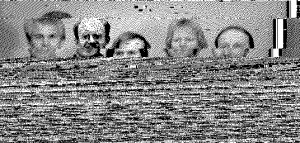
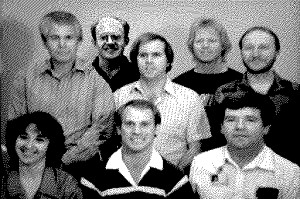
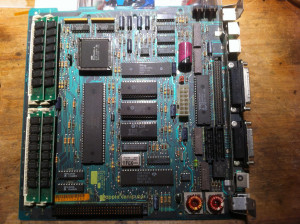
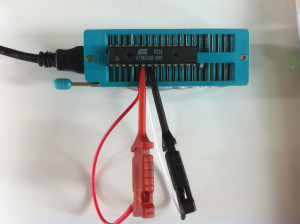
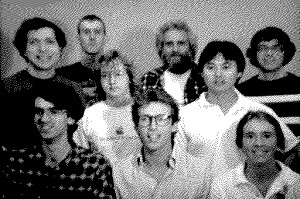
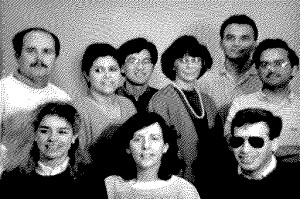
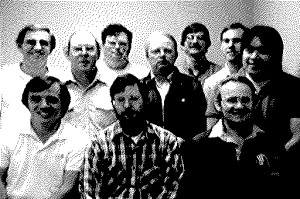

[…] Mayer and Trammell Hudson from NYC Resistor uncovered a series of photos stored in the ROM of an old Macintosh SE. We’ve previously covered the ROM dumping that’s been going on the Brooklyn-based […]
[…] Question Apple Inc.: Apple Inc.: Who are the people in the Mac's ROM easter egg?http://www.nycresistor.com/2012/… Add AnswerBIU @ UpdateLink to Questions, […]
[…] ???????????????????????Macintosh SE?????????????? […]
[…] "CRITEO-300×250", 300, 250); 1 meneos Fantasmas en la ROM [EN] http://www.nycresistor.com/2012/08/21/ghosts-in-the-rom/ por Kaime hace […]
[…] Ghosts in the ROM […]
[…] grupo de programadores do NYCResistor encontrou um antigo Mac SE na rua e decidiu investigar um pouco os mistérios de uma máquina tão antiga. O […]
[…] NYC Resistor un fantástico artículo sobre un huevo de pascua encontrado en la ROM de un Macintosh SE encontrado en la calle. Estos […]
[…] Vía | NYC Resistor […]
[…] with some extra space on the ROM and decided to include some pictures as a fun easter egg.This lengthy post on the NYC Resistor blog offers a crazy behind-the-scenes look at how they managed to uncover these […]
[…] Geek ?????? NYC Resistor??? Dump Rom????????????????????? Dump ? Rom […]
[…] J. Caro nos trae cada semana un artículo sobre los primeros ordenadores de Apple. Al parecer, se han encontrado imágenes en blanco y negro de algunos de los desarrolladores del equipo de Macintosh, encriptadas en el código fuente de la […]
[…] NYC Resistor recently found an old Macintosh SE on a Brooklyn street and noticed an interesting easter egg buried in the ROM after doing some digital digging. […]
[…] NYC Resistor input, textarea{} #authorarea{border:#9EBAC7 1px solid; margin:10px 0px 30px; padding:6px […]
[…] NYC Resistor recently found an old Macintosh SE on a Brooklyn street and noticed an interesting easter egg […]
[…] o artigo dos hackers, intitulado “Ghost in the ROM” (veja aqui), o engenheiro Brian McGhie disse ter sido o responsável pela inclusão das fotos. Ele afirmou que […]
[…] NYC Register did some interesting digging into the Macintosh SE’s ROM to find an Easter Egg. This particular one is the photo of some team members. It’s actually quite interesting that they had enough extra space on the ROM to do that. You’d think for cost reasons they’d go with as little as they could get away with. […]
[…] | NYC Resistors Únete al foro de debate sobre este postArtículos […]
[…] développeurs dans la ROM du Mac SE. Cette photo n’értait visible que depuis le Mac SE mais un utilisateur un peu fou l’a récupérée… Il a donc dumpé la ROM d’un Mac SE, désassemblé le code 68000 et trouvé comment […]